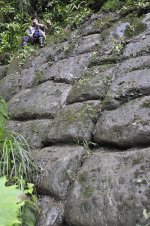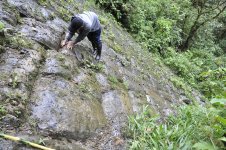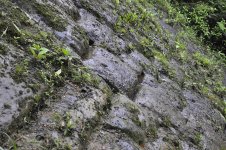Crow
Silver Member
- Jan 28, 2005
- 3,726
- 10,362
- Detector(s) used
- ONES THAT GO BEEP! :-)
- Primary Interest:
- Other
Hello All
There is sadly a there is a very narrow view of Ecuador based on Llangantis Treasure legend Story and other region become largely forgotten..
The following place however is one of many sites not worth the risk of being caught digging on a classified historical site. But interesting to visit all the same. It is interesting to note and wonder how much gold flowed through these Inca strongholds. And do hidden treasures still exist along the Inca roads from around these sites ?
?
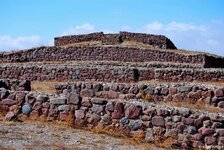
The Pucara Rumicucho is an Ecuadorian archaeological site located in the parish of San Antonio, in the canton of Metropolitan District of Quito, in the province of Pichincha. It has an area of nearly 3acre It was built by the Incas between 1480 and 1500 for military purposes but by the distribution of its architectural space may have also served to religious matters, but have found materials that reveal the previous and simultaneous occupation of local people as Panzaleos quitus, Caranquis and Cuasmal.
The name derives pucará two Quechua voices: "Rumi" (Stone) and "Cucho" (place), by concatenating the voices get "Rumicucho" meaning "corner stone"; although formerly Lulumbamba of "lulum" (fertile) and "Bamba" or "Pampa" (plain) which means "fertile plain" was called.
These terraces have different shapes (rectangular, square and round) and sizes. Distributed pucará shape is elongated in north-south direction. The distribution of spaces is as follows:
First terrace: Place and ritual food consumption.
Second Terrace: Location ritual and consumption.
Third terrace: ceremonial area.
Fourth terrace: Unknown.
Fifth Terrace: Domestic and residential area
Lateral areas: domestic and residential area
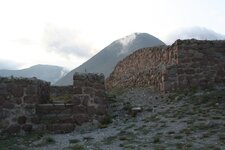
This Ticked various functions such as military, religious and immigration control, but all of them the most important was the first. After the conquests of surrounding areas pucará the Incas built this as a way to consolidate their positions. Most Researchers and archaeologists conclude that the military function Rumicucho met not only by the strategic location in the Pucara was but also the architectural form ie the distribution of spaces and objects found. As for the religious function is notorious architectural form of the third terrace and watching the hills as La Marca and Cayambe, hills are arranged horizontally in an east-west on the equinox the sun walking in that direction and having pucará mind that is within walking distance of half the world. So it follows that Rumicucho was also a place of worship initiation and an astronomical observatory. Besides serving as a checkpoint between Quito and northern peoples, the Incas controlled the entry and exit through Rumicucho Quito.
If ya ever get the chance it might be worth a visit ?... most of these places are usually off the usual western tourist Radar...
?... most of these places are usually off the usual western tourist Radar...
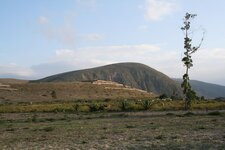
I wonder what secrets these sites hold and what treasures may lie in hidden secret caves and shrines in the countryside around them?
Cheers Crow
There is sadly a there is a very narrow view of Ecuador based on Llangantis Treasure legend Story and other region become largely forgotten..
The following place however is one of many sites not worth the risk of being caught digging on a classified historical site. But interesting to visit all the same. It is interesting to note and wonder how much gold flowed through these Inca strongholds. And do hidden treasures still exist along the Inca roads from around these sites
 ?
?
The Pucara Rumicucho is an Ecuadorian archaeological site located in the parish of San Antonio, in the canton of Metropolitan District of Quito, in the province of Pichincha. It has an area of nearly 3acre It was built by the Incas between 1480 and 1500 for military purposes but by the distribution of its architectural space may have also served to religious matters, but have found materials that reveal the previous and simultaneous occupation of local people as Panzaleos quitus, Caranquis and Cuasmal.
The name derives pucará two Quechua voices: "Rumi" (Stone) and "Cucho" (place), by concatenating the voices get "Rumicucho" meaning "corner stone"; although formerly Lulumbamba of "lulum" (fertile) and "Bamba" or "Pampa" (plain) which means "fertile plain" was called.
These terraces have different shapes (rectangular, square and round) and sizes. Distributed pucará shape is elongated in north-south direction. The distribution of spaces is as follows:
First terrace: Place and ritual food consumption.
Second Terrace: Location ritual and consumption.
Third terrace: ceremonial area.
Fourth terrace: Unknown.
Fifth Terrace: Domestic and residential area
Lateral areas: domestic and residential area

This Ticked various functions such as military, religious and immigration control, but all of them the most important was the first. After the conquests of surrounding areas pucará the Incas built this as a way to consolidate their positions. Most Researchers and archaeologists conclude that the military function Rumicucho met not only by the strategic location in the Pucara was but also the architectural form ie the distribution of spaces and objects found. As for the religious function is notorious architectural form of the third terrace and watching the hills as La Marca and Cayambe, hills are arranged horizontally in an east-west on the equinox the sun walking in that direction and having pucará mind that is within walking distance of half the world. So it follows that Rumicucho was also a place of worship initiation and an astronomical observatory. Besides serving as a checkpoint between Quito and northern peoples, the Incas controlled the entry and exit through Rumicucho Quito.
If ya ever get the chance it might be worth a visit
 ?... most of these places are usually off the usual western tourist Radar...
?... most of these places are usually off the usual western tourist Radar...
I wonder what secrets these sites hold and what treasures may lie in hidden secret caves and shrines in the countryside around them?
Cheers Crow
Amazon Forum Fav 👍
Last edited:



